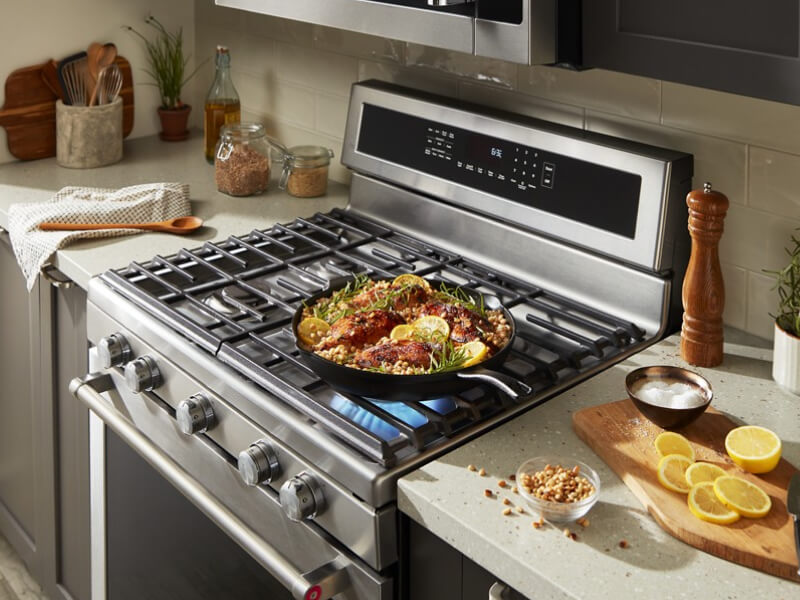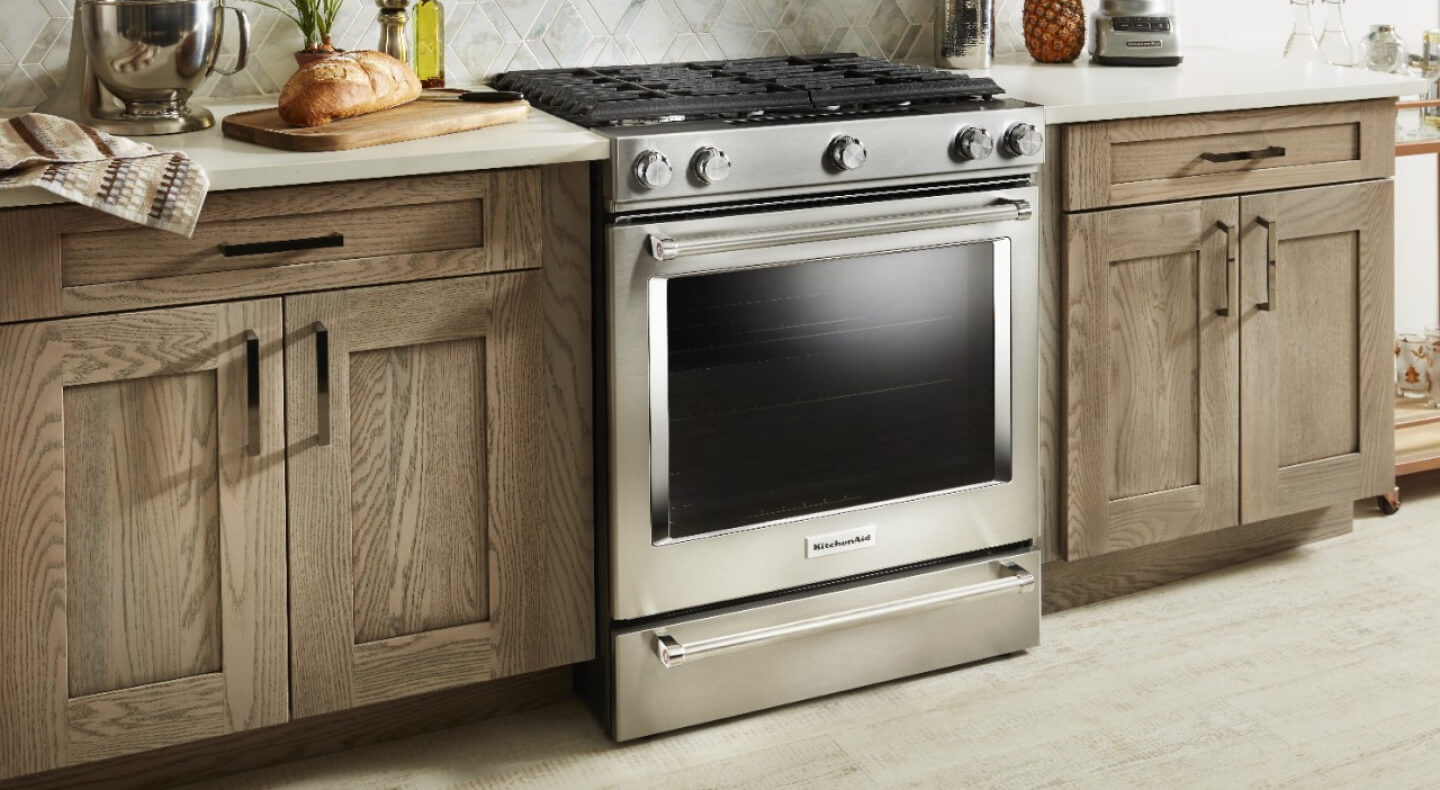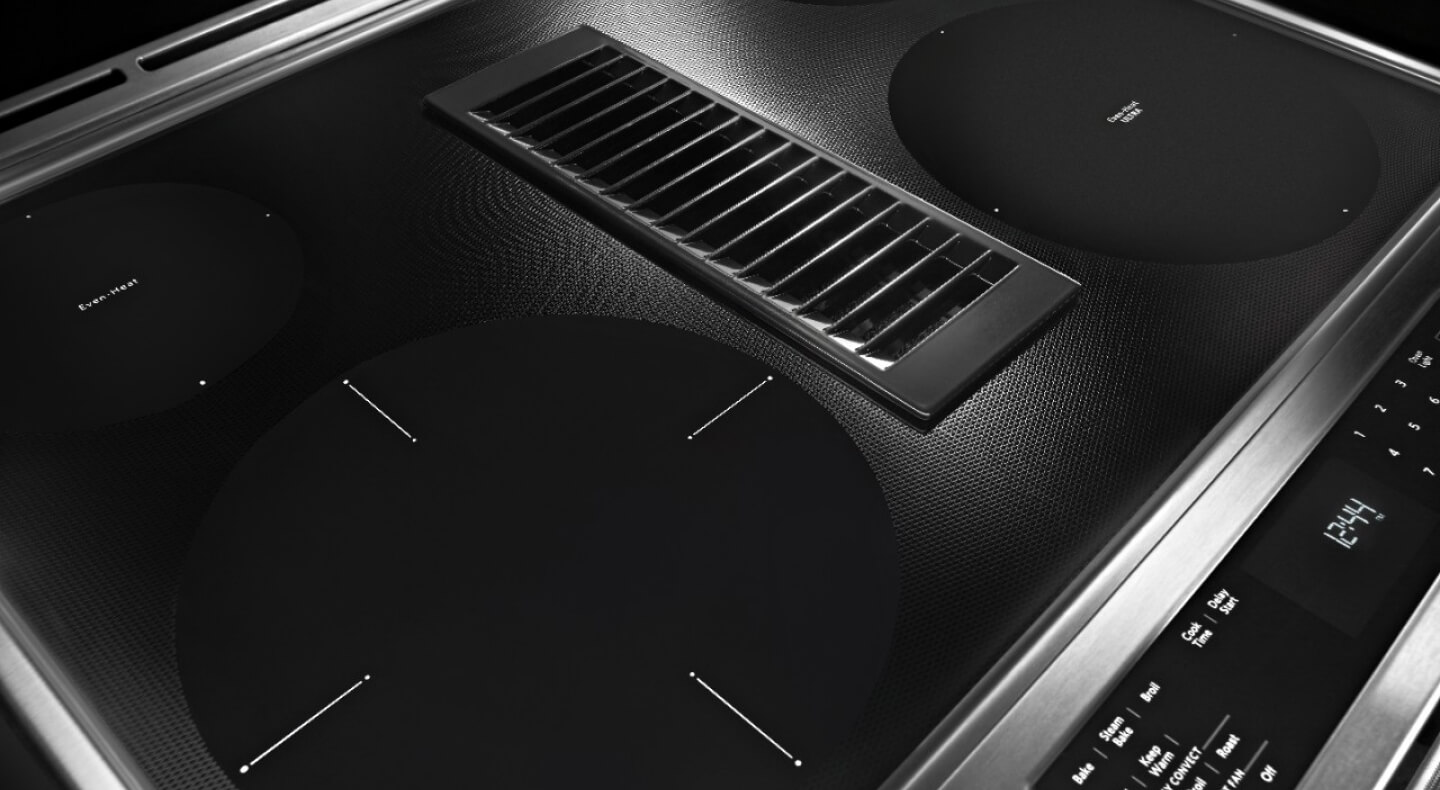
GAS STOVE VS. ELECTRIC STOVE: WHAT’S THE DIFFERENCE?
Gas ranges feature an open flame while electric ranges utilize metal heating elements. Both have their benefits: gas range stovetop burners are highly responsive, allowing you to move between heat levels quickly while electric range ovens tend to have dry, consistent heat that's ideal for baking and roasting.
When it comes to choosing a gas stove vs. electric stove, either type will support your culinary creativity and may even present new possibilities. Read on to learn more about the differences between gas vs. electric ranges and discover which will work best for the unique way you make.
WHAT IS A GAS RANGE?
A gas range uses an open flame to fuel both the oven and the stovetop. Different types of gas burners on the stovetop offer various heat levels that allow you to have optimal control over cooking temperatures. The ability to use both high and low heat levels can help you melt, simmer and fry ingredients with ease. Meanwhile, in the oven, the flame cycles on and off to maintain ideal cooking temperatures.
Keep in mind that gas ranges, rangetops or cooktops require a dedicated gas line. This can easily be installed by a professional if you don't already have it. Learn more about kitchen ranges in this range guide.

NEED HELP CHOOSING A NEW RANGE?
WHAT ARE THE BENEFITS OF A GAS RANGE?
Gas ranges have a reputation for being the favorite among chefs and serious home cooks. Besides the romance of cooking with fire, gas heat can provide a hands-on experience for cooks who are comfortable manipulating an open flame to their culinary advantage. Here are some pros and possibilities:
Responsive stovetop heat
Gas stoves feature an open flame that allows them to have highly responsive stovetops. The open flame can be adjusted instantly, which lets you quickly manipulate the heat level if you notice your dish is cooking too fast or too slow.
Expanded cooking techniques
Gas ranges let you use various types of cookware so you can char or grill food using a cast iron or aluminum grill pan. An open flame can also reach up the side of sculpted pans like woks or skillets for techniques that require you to move food around the sides of the pan.
Fast oven preheating
Because gas heat can be cranked up quickly, gas stoves tend to preheat relatively fast. You can expect to get your creations into the oven faster than an electric range.

KitchenAid® Gas Ranges
ENHANCE THE WAY YOU CREATE
With the power of a KitchenAid® gas range, you have the flexibility to go from a gentle simmer to a rolling boil with ease
SHOP KITCHENAID® GAS RANGES
With multiple burners equipped with a variety of power levels, KitchenAid® gas ranges deliver the flexibility you need to dish out unique culinary creations. Select KitchenAid® gas ranges feature five burners that provide the perfect range of cooking power from 5,000 to 18,000 BTU, so you can go from a delicate simmer to a rolling boil.
WHAT IS AN ELECTRIC RANGE?
An electric range uses heated metal coils to transfer heat to cookware. These metal coils are housed underneath a flat cooking surface, often made of a ceramic-glass blend. Metal coils also provide heat inside the oven and are known to result in consistent temperatures throughout the cavity.
Because your range is where much of the making happens, you’ll need a 220 or 240-volt outlet for an electric model, rather than the 110-volt outlets that may be in other areas of your home. However, it’s highly likely that your kitchen already has this hookup. Learn more different types of stoves or ranges.
WHAT ARE THE BENEFITS OF AN ELECTRIC RANGE?
While gas ranges get a lot of credit for delivering a chef-worthy cooking experience, electric ranges are the unsung hero of both professional and home kitchens. You may be surprised by all the ways an electric range can support your culinary ambitions:
Effective heat transfer
While gas stoves can lose heat since the open gas flame is exposed to surrounding air, electric stove burners heat pots and pans directly, which can help retain heat while cooking.
Dry oven heat
Electric heat tends to be drier than gas. Dry heat is excellent at creating nicely browned results in a variety of dishes, from rustic bread to roast chicken or vegetables.
Stovetop space and versatility
If you tend to have multiple dishes with different-sized cookware in the making at once, electric ranges often offer multi-ring elements that you can switch between based on the width of your cookware, as well as oddly shaped or extra-large elements. Select Kitchenaid® electric ranges feature multi-ring burners such as a triple cooking zone of 6, 9 and 12 inches.
Stovetop cleanability
Electric stovetops can be simple to wipe up because of their flat, smooth surface. Gas stovetops, on the other hand, usually require you to remove cast iron grates so you can clean up below. Find out the best way to clean a griddle on your stovetop.
Induction cooking options
Similar to standard electric ranges, induction stovetops like this KitchenAid® slide-in induction range, feature a glass surface that’s relatively easy to clean. Instead of using a metal coil to heat cookware, induction ranges use electromagnetic energy to turn compatible pots and pans into their own source of heat.
This is why induction ranges have been said to offer the benefits of both electric and gas ranges, since the surface is easy to clean and the heating method delivers the responsiveness needed for precise cooking.

KitchenAid® Electric Ranges
POWERFUL PERFORMANCE DESIGNED TO CREATE
KitchenAid® electric ranges offer powerful performance to match your culinary needs and sleek, elegant style to complement a variety of kitchen designs
SHOP KITCHENAID® ELECTRIC RANGES
Find the flexibility you need to master any meal with precision features available on KitchenAid® electric ranges. Select KitchenAid® electric ranges offer a Triple-Ring Element that provides three burner sizes at one location, so you get the versatility to match your cooking surface to the size of your cookware.
COMPARING GAS STOVE VS. ELECTRIC STOVE BENEFITS
Gas ranges offer an open flame heat source that can be easily manipulated on the stovetop to quickly go from low simmering to high searing, or even charring foods directly. Electric ranges, on the other hand, are typically easier to clean due to their smooth cooktop surface and can provide flexibility with heating elements that come in a variety of sizes and heat levels.


WANT BOTH GAS AND ELECTRIC?
Dual fuel ranges feature a gas stovetop and an electric oven so you can cook with the benefits of both. Browse KitchenAid® dual fuel ranges to learn more.
IS A GAS OR ELECTRIC STOVE BETTER FOR ADVANCED COOKING TECHNIQUES?
Your creativity in the kitchen shouldn’t be limited by the type of range you have. Gas ranges open up some cooking styles specific to an open flame like charring or grilling food right on the stovetop with the help of a cast iron or aluminum grill pan. Gas burners are also great for stir-frying or high-heat sautéing. These techniques require food to be moved quickly around the pan so it doesn’t burn. Flames reaching up the side of a pan allow you to cook the food as you use the sides of the pan to flip or rotate the ingredients.
While gas ranges allow you to cook directly with an open flame, techniques like charring, grilling, stir-frying and sautéing are still possible in an electric range. For instance, you can char peppers under a broiler or grill with a grill pan on the stovetop.
TOP TECHNIQUES FOR GAS VS. ELECTRIC STOVES
See which fuel type comes out on top when tasked with these classic culinary techniques.

BAKE, BROIL AND ROAST
Electric ranges tend to provide dry heat that can help create a crispy crust or beautiful brown on dishes like baked pasta, broiled salmon or roasted chicken. This KitchenAid® Combination Wall Oven offers Even-Heat™ True Convection, which features a unique bow-tie design with a heating element and fan that circulates hot air throughout the entire oven.

SEAR
Both gas and electric heat on the stovetop will get a pan hot enough to deliver a nice sear on meats, vegetables and fruits. Extra high heat burners are sometimes available in commercial gas ranges. For example, select KitchenAid® commercial ranges feature burners with a 20,000 BTU rating.

STIR-FRY AND SAUTÉ
The open flame from a gas range can be helpful with stir frying or sautéing since you can move food around the sides of the pan as the flame heats the sides of cookware. The KitchenAid® Commercial Style Rangetop has three-level convertible grates with removable inserts that match the heat to your technique. Simply leave the insert level for high-heat searing and sautéing, flip it over to lift your pan above the flame to simmer and melt or remove it to nestle a round-bottom wok in the flame for stir-frying.

SIMMER
Both gas and electric ranges should allow you to hold a steady simmer in soups, stews and braises. Gas burners generally cool down faster than electric and will allow you to move from a boil to a simmer more quickly. The KitchenAid® 5-Burner Gas Convection Range offers burners with a BTU range of 5,000 to 18,000 so you can easily move between heat levels.

BOIL
Gas and electric heat on the stovetop should help you reach and hold a boil quickly and easily. Gas burners heat up fast since the flame can be adjusted instantly, but electric elements also transfer heat very effectively to cookware since the heat is contained rather than open and exposed. Electric ranges also often offer multi-ring elements to accommodate small saucepans or large stockpots, like the Triple-Ring Element by KitchenAid brand.

STEAM
Steaming is a moist-heat method of cooking that works by boiling water which evaporates into steam and can be achieved with gas or electric heat. Select ranges featuring the KitchenAid® Steam Rack offer the ability to provide additional moisture to the inside of the oven, enhancing cooking results.
CAN YOU REPLACE A GAS STOVE WITH ELECTRIC?
You can make the switch from a gas range to an electric model, however, you may need to enlist the help of a professional to install the proper energy source. Keep reading for more information on how to switch from gas to electric and vice versa.

KitchenAid® ranges
A range for every kitchen
Explore slide-in and freestanding ranges crafted for performance and style to help you create your favorite recipes


Electric to gas
When switching from an electric range to a gas model, check to determine whether your kitchen has an existing gas line or if you’ll need to hire a professional to install one. If you have a gas line installed, you may need to determine whether it runs on natural gas or propane.
If you need a plumber to install a gas line, this may cost anywhere from $500 to $2,000. You will also need an electrician to change your 220/240-volt outlet to a 110-volt outlet.
Gas to electric
If you’re switching from a gas range to an electric model, check if your kitchen has the correct outlet. You’ll need an electrician to install a 220/240-volt outlet with a dedicated circuit. Learn more about how to switch from a gas stove to an electric model.
SHOP FOR GAS AND ELECTRIC KITCHENAID® RANGES
KitchenAid® gas and electric ranges offer features designed for precision and flexibility. Select models have features like 5 Burners that provide a range of cooking power from 5,000 to 17,000 BTUs, and a 10" Even-Heat™ Ultra Power™ Element that maintains a constant supply of power across the cooktop, giving you endless ways to create.

DESTINATION: DESIGN
FOLLOW THE PATH TO INSPIRATION
Join two creative storytellers as they travel to a unique destination, and watch as KitchenAid brand transforms their inspiration into stunning designs







